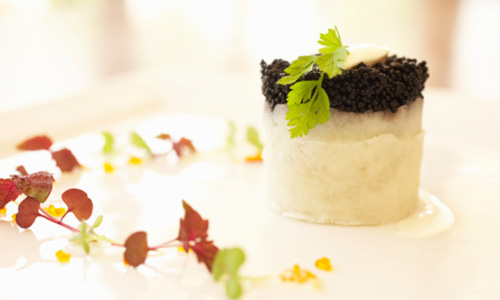
Ingredients for 6 persons:
- 300 g floury potatoes
- 50 g spring onions (only the white part)
- 1 finger-long piece of lemongrass
- 200 ml shellfish stock (from the jar; alternatively fish stock)
- sea salt, freshly ground pepper
- 6 king prawns (raw, with shells, approx.
150 g) - 2 cloves of garlic
- 1 tbsp olive oil
- 1 splash of dry vermouth (e.g. Noilly Prat)
- 300 ml whipping cream
- 4 sheets of white gelatine
- 100 g caviar of your choice (genuine Russian caviar, trout caviar or salmon caviar)
For the Sauce:
- 1 shallot
- 1 tbsp olive oil
- 3 tbsp aniseed liqueur
- 50 ml white wine
- 100 ml shellfish stock (from the jar)
- 125 g crème fraîche
- salt, pepper
In addition:
- Small slices of lemon and herbs to garnish
Preparation:
- Peel, wash and cut potatoes into large pieces. Clean, rinse and very finely dice spring onions. Rinse lemongrass and pound it flat using the back of a knife. Place potatoes, spring onions, lemongrass and shellfish stock into a pan. Season with some salt and pepper. Boil covered for approx. 20 minutes.
- Rinse king prawns and remove shells (put shells aside for the sauce). Peel and halve garlic. Heat olive oil. Sauté prawns and garlic in this. Quench with vermouth. Pour on 150 ml cream. Season with some salt and pepper. Boil up cream. Remove the pan from the heat and let the prawns simmer in it for 3-5 minutes.
- Soak gelatine in cold water for 5 minutes. Take prawns out of the cream stock. Let the stock thicken for approx. 3-4 minutes. Remove garlic. Squeeze the water out of the gelatine and let gelatine dissolve in the cream stock.
- Crush the potatoes in the stock using a potato masher (remove lemongrass beforehand). Mix cream stock with a whisk. Leave the mixture to cool.
- Whip the remaining cream until stiff. Finely dice prawns. Combine cream and prawns with the potato mixture. Add salt and pepper to taste. Rinse out 6 ramekins (or small glass cups, approx. 125 ml capacity) with cold water. Fill with potato mixture.
- Put in the fridge for 2-3 hours.
- Peel and dice shallot for the sauce. Heat olive oil. Sear shallot and prawn shells in it. Quench with aniseed liqueur and white wine. Boil liquid over a high heat. Pour in shellfish stock and simmer for 3-5 minutes. Strain everything through a fine sieve into a second pan. Stir in crème fraîche and simmer the creamy sauce. Add salt and pepper to taste.
- Loosen the edge of the potted prawn/potato mixture using a sharp knife. Turn out potted servings onto plates. Put caviar on top and put the sauce onto the plates. Garnish the potted servings with lemon and herbs.
Click here for more information on cooking and baking with gelatine.
Nutritional values per person approx.:
- Calories: 359
- Joules: 1505
- Protein: 12.5 g
- Fat: 29.7 g
- Carbohydrates: 11 g
A delicate, luxury side dish
A potted dish made of prawns, potatoes and an exquisite topping of caviar. This small work of art can make the beholder’s mouth water. The contrast from the humble potato and luxurious caviar ensures the desired wow factor here – a combination which is above all popular with chefs. With the aid of form-giving gelatine, this refined recipe can also work in your own kitchen.
Caviar – ‘black gold’
Shiny, grey-black beadlets the size of a pin head and a gentle aroma which is evocative of a fresh sea breeze – caviar, the precious roe of the female sturgeon is without doubt something special. Some call it ‘black gold’; others the most precious ingredient in the gourmet kitchen. A distinction is made between genuine caviar, cultured caviar and caviar substitute. There is also trout and salmon caviar, the bright red colour of which stands out. Freshly caught sturgeon’s roe is brilliant and glassy. After cleaning, it is covered with salt. Only afterwards does the delicacy get its black colouring. Only lightly salted varieties are called malossol caviar. They have a comparatively low salt content of 2 to 4 per cent and are regarded as particularly high quality. In contrast to this, there is barrel or salted caviar, which has a salt content of 10 to 12 per cent. In turn, this has a comparatively longer shelf life and is also less expensive.
Salt content affects quality
The term caviar supposedly comes from the Persian and was firstly found in the records of an Iranian tribe which lived by the Caspian Sea. Besides the Caspian Sea, the origin of the most precious types of caviar is the Black Sea or the Sea of Asov. The genuine Russian caviar is extracted from the roe of the Beluga, Sevruga or Ossietra sturgeon species. In addition to the species, differences in the quality and price also depend on age: the older the female sturgeon is when the roe is extracted, the higher the quality and the more intensive the flavour of the caviar.
Tip for consumption
Caviar should not be eaten using metal or even silver spoons, as they can tarnish and give the roe an unpleasant taste. Plastic or mother-of-pearl spoons are more suitable for consumption. Champagne and dry white wine can be recommend as ideal accompaniments, as they bring out its characteristic taste. You should serve the caviar chilled – we wish you every success and bon appétit!